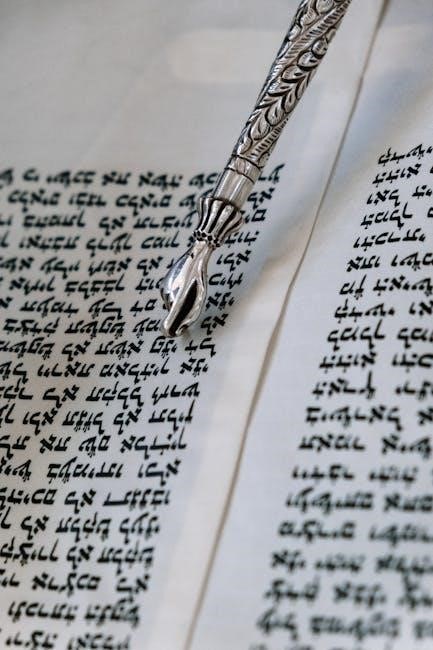
oklahoma script pdf
Oklahoma! is the groundbreaking first collaboration between Richard Rodgers and Oscar Hammerstein II‚ adapting Lynn Riggs’ 1931 play Green Grow the Lilacs․ Set in the Oklahoma Territory‚ it blends music‚ drama‚ and dance‚ exploring themes of love‚ community‚ and conflict․ The script‚ available in PDF‚ remains a cornerstone of Broadway history‚ offering insights into its timeless appeal and cultural significance․
1․1 Historical Background of the Musical
Oklahoma! premiered on March 31‚ 1943‚ at the St․ James Theatre in New York‚ marking a pivotal moment in Broadway history․ Adapted from Lynn Riggs’ 1931 play Green Grow the Lilacs‚ it was the first collaboration between Richard Rodgers and Oscar Hammerstein II․ The musical revolutionized theater by integrating music‚ drama‚ and choreography seamlessly․ Set in the early 20th-century Oklahoma Territory‚ it captures the lives of settlers‚ blending romance and conflict․ Its innovative storytelling and memorable score solidified its legacy as a groundbreaking work in American musical theater․
1․2 The Significance of “Oklahoma!” in Broadway History
Oklahoma! redefined Broadway by fusing music‚ dance‚ and drama into a cohesive narrative․ Its 1943 debut introduced the concept of the “integrated musical‚” where every song and scene advanced the plot․ This innovation raised the bar for musical theater‚ influencing future productions․ The show’s success also highlighted the importance of collaboration between composers and librettists‚ setting a new standard for creative partnerships․ Its impact remains evident‚ making it a landmark production in Broadway’s evolution․
1․3 Overview of the Plot and Themes
Oklahoma! is set in the early 20th-century American West‚ focusing on the lives of farmers and cowboys․ The story revolves around the rivalry between Curly McLain and Jud Fry for Laurey Williams’ affection․ Themes of love‚ jealousy‚ and community are intertwined with the challenges of frontier life․ The musical explores the tension between tradition and progress‚ as well as the struggle for identity in a changing world․ Its blend of romance‚ humor‚ and drama creates a timeless narrative that captivates audiences․

The Script and Lyrics
The script‚ written by Oscar Hammerstein II‚ adapts Green Grow the Lilacs into a groundbreaking musical․ Richard Rodgers’ iconic score complements the heartfelt lyrics‚ creating a timeless classic․
2․1 Structure of the Script
The script of Oklahoma! is structured to seamlessly integrate dialogue‚ song‚ and dance‚ breaking from traditional musical theater norms․ It opens with Curly’s iconic song‚ setting the tone for the narrative․ The story unfolds through balanced dialogue and musical numbers‚ with songs like “Oh‚ What a Beautiful Mornin'” and “People Will Say We’re in Love․” The script’s innovative structure influenced future musicals‚ emphasizing music and drama as equal storytelling elements․ This approach created a cohesive and engaging experience‚ marking a milestone in Broadway history․
2․2 Key Scenes and Dialogues
The script of Oklahoma! features memorable scenes that drive the plot and develop characters․ The box social auction showcases Curly and Laurey’s budding romance‚ while the tense confrontation between Curly and Jud in the barn highlights their rivalry․ Dialogues like Laurey’s rejection of Jud and Curly’s charming proposals reveal deep emotional layers․ These pivotal moments‚ combined with iconic songs‚ create a compelling narrative that blends humor‚ drama‚ and music‚ making the script a masterclass in storytelling and character interaction․
2․3 Analysis of the Lyrics by Oscar Hammerstein II
Oscar Hammerstein II’s lyrics in Oklahoma! are celebrated for their poetic depth and emotional resonance․ His words vividly capture the essence of the American frontier‚ blending humor‚ romance‚ and drama․ Songs like “Oh‚ What a Beautiful Mornin'” and “People Will Say We’re in Love” showcase his ability to convey complex emotions through simple‚ relatable language․ Hammerstein’s lyrics not only advance the plot but also deepen character development‚ making them integral to the musical’s enduring success and timeless appeal․
The Book by Oscar Hammerstein II
Oscar Hammerstein II’s book for Oklahoma! masterfully adapts Lynn Riggs’ Green Grow the Lilacs‚ balancing drama and music while exploring themes of love and rivalry in the American frontier․
3․1 Adaptation from Lynn Riggs’ “Green Grow the Lilacs”
Oscar Hammerstein II adapted Lynn Riggs’ 1931 play Green Grow the Lilacs‚ transforming its folklore-inspired narrative into the musical Oklahoma!․ The adaptation retained the original’s rural Oklahoma setting and characters‚ including Curly and Laurey‚ while enhancing the emotional depth and thematic complexity․ Hammerstein’s adaptation introduced iconic songs and choreography‚ elevating the story into a landmark Broadway production․ The script PDF reveals how Riggs’ dialogue and plot were seamlessly integrated with Rodgers’ music‚ creating a theatrical masterpiece․
3․2 Character Development in the Book
Oscar Hammerstein II’s book for Oklahoma! masterfully develops its characters‚ drawing from Lynn Riggs’ original play․ Curly McLain emerges as a charming‚ confident cowboy‚ while Laurey Williams is portrayed as a strong-willed‚ independent farm girl․ The antagonist‚ Jud Fry‚ is deeply complex‚ revealing a troubled and misunderstood soul․ Supporting characters like Ado Annie and Will Parker add humor and depth․ Hammerstein’s dialogue and narrative structure ensure each character’s personality and motivations shine‚ creating a rich emotional landscape that captivates audiences and drives the story forward․
3․4 Themes and Symbolism in the Storyline
The storyline of Oklahoma! explores themes of love‚ community‚ and the clash between tradition and progress․ Symbolism is evident in the Oklahoma wind‚ representing change and the inevitable passage of time․ The open plains symbolize freedom and opportunity‚ while the farm signifies stability and the American Dream․ The rivalry between Curly and Jud mirrors the struggle between hope and despair‚ adding depth to the narrative․ These elements weave together to create a rich tapestry of meaning‚ making the musical a timeless exploration of human emotions and societal transformation․

The Music by Richard Rodgers
Richard Rodgers’ score for Oklahoma! revolutionized musical theater with its innovative blend of classical and popular music․ His iconic songs‚ like “Oh‚ What a Beautiful Mornin!‚” seamlessly integrate with Oscar Hammerstein II’s lyrics‚ advancing the plot and deepening character emotions․ Rodgers’ compositions not only elevated the storytelling but also set a new standard for Broadway musicals‚ ensuring the show’s enduring legacy․
4․1 Composition and Musical Style
Richard Rodgers’ compositions for Oklahoma! showcase a blend of operetta and American folk music‚ creating a distinct sound․ His use of soaring melodies‚ harmonic richness‚ and orchestral textures brought depth to the musical․ Rodgers’ ability to craft memorable‚ hummable tunes‚ such as “Oh‚ What a Beautiful Mornin!” and “People Will Say We’re in Love‚” established a new standard for Broadway scores․ His style seamlessly integrated music with storytelling‚ elevating both the narrative and emotional impact of the production․ This innovative approach remains influential in musical theater today․
4․2 Iconic Songs from the Musical
The musical Oklahoma! features timeless songs that have become synonymous with Broadway․ Numbers like “Oh‚ What a Beautiful Mornin!”‚ “People Will Say We’re in Love”‚ and the titular “Oklahoma!” are memorable and emotionally resonant․ These songs‚ with their soaring melodies and heartfelt lyrics‚ have transcended the stage‚ becoming staples of American musical theater․ Their enduring popularity highlights the genius of Rodgers and Hammerstein’s collaboration‚ blending romance‚ humor‚ and drama into unforgettable musical moments that captivate audiences worldwide․
4․3 The Role of Music in Advancing the Plot
Rodgers’ score for Oklahoma! masterfully advances the plot by mirroring character emotions and dramatic tension․ Songs like “Oh‚ What a Beautiful Mornin!” establish Curly’s optimism‚ while “Lonely Room” reveals Jud’s inner turmoil․ The music bridges scenes‚ heightens drama‚ and deepens connections between characters․ Rodgers’ innovative orchestration and Hammerstein’s lyrics seamlessly integrate‚ creating a narrative that unfolds as much through melody as dialogue‚ setting a new standard for musical storytelling and emotional depth․

Availability of the Script in PDF Format
The Oklahoma! script is widely available in PDF format from various online sources‚ including free downloads and purchasable versions‚ ensuring easy access for theater enthusiasts and researchers․
5․1 Sources for Downloading the Script
The Oklahoma! script in PDF format can be downloaded from various online sources‚ including Google Drive links‚ educational platforms‚ and the official Rodgers & Hammerstein website․ Additionally‚ it is available on platforms like Amazon‚ eBay‚ and academic databases․ Some websites offer free downloads‚ while others may require purchase․ Ensure compliance with copyright laws when accessing or using the script․ These sources provide convenient access for theater enthusiasts‚ students‚ and researchers interested in studying the musical․
5․2 Legal Considerations for Using the Script
Using the Oklahoma! script requires adherence to copyright laws‚ as it is protected under the rights of Rodgers & Hammerstein․ Unauthorized distribution or performance without proper licensing is illegal․ Obtain permission from official sources like the Rodgers & Hammerstein Organization․ Violating copyright can lead to legal consequences‚ including fines․ Ensure all uses comply with licensing agreements to respect intellectual property rights and support the creators’ legacy․
5․3 Differences Between the Script and the Original Play
The Oklahoma! script differs from Lynn Riggs’ original play Green Grow the Lilacs in several key aspects․ The musical adds iconic songs like The main characters in Oklahoma! are Curly McLain‚ Laurey Williams‚ Jud Fry‚ and others․ Their relationships and conflicts form the heart of the musical‚ blending romance and drama․ Curly McLain is the charming and confident male lead in Oklahoma!․ A cowboy with a heart of gold‚ he embodies optimism and resilience․ His romance with Laurey Williams drives the story‚ while his rivalry with Jud Fry adds tension․ Curly’s character represents hope and determination‚ making him the moral center of the musical․ His interactions showcase his wit and courage‚ ultimately leading to the resolution of conflicts and the triumph of love and community․ Laurey Williams is the spirited and independent female lead in Oklahoma!․ A strong-willed farm girl‚ she captivates with her charm and resilience․ Her journey revolves around choosing between Curly and Jud‚ symbolizing internal conflict․ Laurey’s character represents femininity and determination‚ making her a central figure in the musical․ Her interactions with Curly highlight her humor and grace‚ while her struggles with Jud reveal her courage․ Laurey’s story is a testament to female strength and the pursuit of happiness․ Jud Fry is the brooding and troubled antagonist in Oklahoma!․ A loner with a dark past‚ he harbors unrequited love for Laurey Williams․ His character embodies raw emotion and internal conflict‚ making him a complex figure․ Jud’s interactions with Curly and Laurey drive much of the plot’s tension․ His tragic downfall underscores themes of isolation and the struggle between good and evil․ Jud’s role adds depth to the musical‚ highlighting the darker aspects of human nature and the consequences of unchecked emotions․ Other key characters in Oklahoma! include Ado Annie‚ a flirtatious and charming young woman torn between suitors; Will Parker‚ a rugged cowboy with a knack for storytelling; and Ali Hakim‚ a Persian peddler whose humor and wit add comedic relief․ These characters enrich the story‚ exploring themes of love‚ ambition‚ and community․ Their interactions with Curly‚ Laurey‚ and Jud drive the plot forward‚ contributing to the musical’s dynamic and engaging narrative․ Each character brings unique traits that enhance the overall drama and charm of the story․ Oklahoma! debuted on Broadway in 1943‚ running for 2‚212 performances․ Its innovative choreography by Agnes de Mille and heartfelt storytelling set a new standard for musical theater‚ blending drama and music seamlessly․ The original Broadway production of Oklahoma! opened on March 31‚ 1943‚ at the St․ James Theatre․ Directed by Rouben Mamoulian‚ it featured choreography by Agnes de Mille‚ marking the first time ballet was integrated into a musical․ The show ran for 2‚212 performances‚ setting a new record․ Its success was unprecedented‚ revolutionizing musical theater by blending storytelling‚ music‚ and dance․ The production starred Alfred Drake as Curly and Joan Roberts as Laurey‚ becoming a landmark in Broadway history․ Oklahoma! has seen numerous revivals and adaptations since its debut․ The 1955 film version brought the musical to a wider audience‚ while the 1998 London revival at the Royal National Theatre introduced a darker‚ grittier interpretation․ In 2019‚ a stripped-down Broadway revival directed by Daniel Fish earned critical acclaim and won the Tony Award for Best Revival of a Musical․ These adaptations highlight the script’s versatility‚ allowing fresh interpretations while maintaining its core emotional depth and historical significance․ Choreography in Oklahoma! was revolutionary‚ thanks to Agnes de Mille‚ who merged ballet and folk dance․ Her iconic “Dream Ballet” sequence and energetic ensemble numbers like “Kansas City” and “The Farmer and the Cowman” became integral to the storytelling․ The dances reflected characters’ emotions and relationships‚ blending seamlessly with the script․ This innovative approach elevated the musical’s dramatic impact and set a new standard for choreography in Broadway productions‚ influencing future musicals and remaining a key element in revivals and adaptations․ Oklahoma! explores themes of love‚ community‚ and conflict‚ set against the backdrop of frontier life․ It highlights the struggle between individualism and unity‚ reflecting the human spirit’s resilience and hope․ Love and romance are central to Oklahoma!‚ as seen in the tender yet tense relationship between Curly and Laurey․ Their courtship‚ marked by playful banter and deeper emotions‚ highlights the complexities of love in a frontier setting․ The musical portrays romance as a unifying force‚ bridging individual aspirations and communal bonds․ The script PDF captures these dynamics through heartfelt dialogues and iconic songs like “People Will Say We’re in Love‚” underscoring the transformative power of love amid conflict and uncertainty․ Community and unity are vividly portrayed in Oklahoma! as settlers in the Oklahoma Territory join forces to overcome challenges․ The script highlights how collective efforts‚ such as box socials and shared labor‚ strengthen bonds among residents․ The musical emphasizes the importance of solidarity in building a thriving society․ Through scenes like the lively town gatherings‚ the story underscores how unity fosters hope and resilience‚ reflecting the pioneering spirit of the American frontier․ The PDF script captures these moments‚ illustrating the power of community in shaping individual and shared destinies․ Conflict and resolution drive the narrative of Oklahoma!‚ with tensions between Curly and Jud Fry forming a central plot․ Their rivalry escalates‚ culminating in a dramatic confrontation․ Meanwhile‚ Laurey’s difficult choice between Curly and Jud adds emotional depth․ The script resolves these conflicts through a combination of community intervention‚ justice‚ and personal sacrifice․ The PDF highlights how these resolutions reinforce themes of unity and moral justice‚ ultimately restoring harmony to the Oklahoma Territory’s settlers and their aspirations for a better future․ Oklahoma! remains timeless‚ offering universal themes of love‚ community‚ and conflict; Its exploration of human emotions and societal dynamics continues to resonate‚ making the PDF script a valuable resource for contemporary theater studies and adaptations‚ ensuring its enduring relevance in modern cultural and educational contexts․ The story of Oklahoma! endures due to its universal themes of love‚ community‚ and personal struggle․ Set in the Oklahoma Territory‚ it captures the spirit of frontier life and the human quest for belonging․ The musical’s exploration of complex relationships‚ such as Curly and Laurey’s romance‚ resonates across generations․ Its blend of humor‚ drama‚ and music creates a narrative that is both nostalgic and relatable‚ ensuring its appeal remains strong in contemporary audiences․ Oklahoma! holds profound cultural and historical significance as the first major musical to seamlessly integrate music‚ drama‚ and dance․ Reflecting the spirit of the American frontier‚ it captures the struggles and aspirations of early 20th-century settlers․ The musical’s honest portrayal of social dynamics and its innovative storytelling set a new standard for Broadway․ Its exploration of themes like community and identity continues to resonate‚ making it a landmark work in American theater history and a testament to the power of musical storytelling․ The Oklahoma! script offers invaluable insights for theater students‚ showcasing the integration of music‚ dialogue‚ and choreography․ Its structured format and character development provide a masterclass in storytelling․ The PDF availability allows for detailed analysis of scenes‚ lyrics‚ and stage directions․ Students can study how the musical reflects historical contexts and societal themes‚ making it a rich resource for understanding the evolution of American musical theater and its enduring influence on contemporary productions․ Oklahoma! is a landmark musical that revolutionized Broadway‚ blending music and drama․ Its script‚ available in PDF‚ remains a vital resource for theater enthusiasts and scholars alike․ The Oklahoma! script‚ available in PDF‚ is a landmark musical blending music‚ drama‚ and dance․ It explores themes of love‚ community‚ and conflict‚ set in the Oklahoma Territory․ Adapted from Lynn Riggs’ Green Grow the Lilacs‚ it revolutionized Broadway with its integrated storytelling․ The script remains a vital resource for theater enthusiasts and scholars‚ offering insights into its timeless appeal and cultural significance․ Its availability in PDF format ensures accessibility for study and appreciation of this groundbreaking work․ The Oklahoma! script remains a cornerstone of musical theatre history‚ showcasing the innovative integration of music‚ drama‚ and dance․ Its exploration of themes like love‚ community‚ and conflict continues to resonate‚ making it a vital study for theatre enthusiasts and scholars․ As a blueprint for modern musicals‚ it offers timeless lessons in storytelling and character development․ Its enduring popularity highlights its cultural and artistic significance‚ ensuring its relevance for future generations of performers‚ writers‚ and audiences alike․ For deeper understanding‚ explore Rodgers and Hammerstein’s Oklahoma!: The Complete Book and Lyrics․ Additionally‚ The Rodgers and Hammerstein Story by Stanley Green offers insights into their collaboration․ Oklahoma! The Making of an American Musical by Tim Carter provides historical context․ Seek scholarly articles on the musical’s impact and adaptations․ Online forums and theatrical communities also offer valuable discussions and resources for further exploration of this iconic musical․ Find the Oklahoma! script in PDF format through academic sources‚ theatrical archives‚ and online communities․ Explore books like Rodgers and Hammerstein’s Oklahoma! for deeper insights․ Access the Oklahoma! script in PDF format through various reliable sources․ Official websites like the Rodgers & Hammerstein Organization offer authorized downloads․ Academic databases and theatrical archives also provide access to the original 1949 script․ Additionally‚ platforms like Google Scholar and educational repositories host PDF versions for research purposes․ Ensure to verify the legality and quality of the source before downloading․ Use specific search terms like “Oklahoma script PDF” or “Rodgers and Hammerstein Oklahoma!” for accurate results․ Extensive literature explores the creation and legacy of Oklahoma!․ Books like “The Rodgers and Hammerstein Story” and academic articles analyze the musical’s historical impact and artistic innovations․ Essays in theatrical journals discuss its adaptation from “Green Grow the Lilacs” and its influence on modern musical theater․ These resources provide deep insights into the collaboration between Rodgers and Hammerstein‚ as well as the cultural significance of the show․ They are available through academic databases‚ libraries‚ and theatrical archives․ Online communities and forums dedicated to theater and musicals often discuss Oklahoma! and its script․ Platforms like Reddit‚ theater enthusiast forums‚ and Facebook groups host lively discussions about the musical’s history‚ themes‚ and performances․ These spaces also share links to script PDFs‚ analysis‚ and historical context‚ making them valuable resources for researchers and fans alike․ They provide a space for collaborative learning and sharing among enthusiasts of Rodgers and Hammerstein’s iconic work․ Academic Sources: Studies by Santos et al; (2010) and O Lebrasseur (2021) provide insights into script analysis and historical context․ Academic studies like O Lebrasseur (2021) and Santos et al․ (2010) provide script analysis and historical context․ These works explore the musical’s structure‚ themes‚ and cultural impact․ They offer insights into the collaboration between Rodgers and Hammerstein‚ as well as the adaptation from Riggs’ play․ These sources are essential for understanding the musical’s significance and its enduring influence on Broadway․ They are available through academic databases and theater studies resources‚ offering a scholarly perspective on the script and its legacy․ Primary sources include the complete book and lyrics by Rodgers and Hammerstein‚ available in PDF format․ The original play Green Grow the Lilacs by Lynn Riggs serves as the foundation․ Scripts and scores‚ such as Oklahoma Full Score․pdf‚ provide direct access to the musical’s composition․ These documents are invaluable for studying the work’s creation and execution․ They are often available through official theatrical archives and trusted online repositories‚ ensuring authenticity and accessibility for researchers and enthusiasts alike․ Online resources for the Oklahoma! script and related materials are abundant․ Websites offer free PDF downloads of the script‚ scores‚ and lyrics‚ such as Oklahoma Score PDF and Oklahoma Full Score․pdf․ Platforms like Google Drive and Scribd host these files‚ while forums and communities discuss the musical’s historical and cultural significance․ These resources provide access to musical numbers‚ character descriptions‚ and production notes‚ making them invaluable for researchers‚ performers‚ and enthusiasts․ Ensure to verify the legality and authenticity of these sources to avoid copyright issues․
Main Characters in “Oklahoma!”
6․1 Curly McLain: The Hero
6․2 Laurey Williams: The Female Lead
6․3 Jud Fry: The Antagonist
6․4 Other Key Characters

Stage Productions and Performances
7․1 The Original Broadway Production
7․2 Notable Revivals and Adaptations
7․3 The Role of Choreography in the Musical

Themes and Messages
8․1 Love and Romance
8․2 Community and Unity
8․3 Conflict and Resolution

The Script’s Relevance in Modern Times
9․1 Timeless Appeal of the Story
9․2 Cultural and Historical Significance
9․3 Educational Value for Theater Students
10․1 Summary of Key Points
10․2 Final Thoughts on the Script’s Importance
10․3 Recommendations for Further Reading

Additional Resources
11․1 Links to Download the Script PDF
11․2 Books and Articles About “Oklahoma!”
11․3 Online Communities and Forums

References
Primary Sources: The original script and lyrics by Rodgers and Hammerstein are essential references․
Online Resources: PDFs and analyses available on platforms like Google Scholar and theater archives․12․1 Academic Sources
12․2 Primary Sources
12․3 Online Resources
Related Posts

carrier comfortlink alarm codes pdf
Download the comprehensive Carrier ComfortLink alarm codes PDF guide for easy troubleshooting and system maintenance. Get instant access now!
squallywood pdf
Download Squallywood PDF instantly. Get your free copy now!

gottman worksheets for couples pdf
Strengthen your relationship with free Gottman worksheets for couples. Download printable PDFs based on research-backed strategies to improve communication and connection.